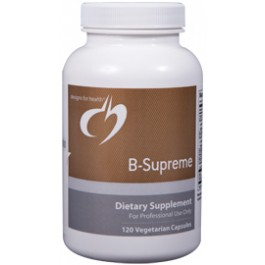
Quick Overview
This very powerful B vitamin combination formula supplies most of the B vitamins in their coenzymated forms so the body does not have to phosphorylate...
Coenzyme Q10
By Gene Bruno, MS, MHS – Dean of Academics, Huntington College of Health Sciences
 Although structurally related to vitamin K, coenzyme Q 10 (CoQ10) is not a vitamin, but rather coenzyme that helps to utilize oxygen as part of its important role in cellular energy metabolism. Research has also shown that CoQ10 functions in a number of other beneficial ways including free radical scavenging.1 Following is a brief review of that research.
Although structurally related to vitamin K, coenzyme Q 10 (CoQ10) is not a vitamin, but rather coenzyme that helps to utilize oxygen as part of its important role in cellular energy metabolism. Research has also shown that CoQ10 functions in a number of other beneficial ways including free radical scavenging.1 Following is a brief review of that research. Chemically, free radicals can be defined as a molecule with an unpaired electron. In the process of trying to balance itself by gaining or losing an electron, the free radical causes oxidative damage on a cellular level. CoQ10 has the unique property of being able to accept or donate an electron without itself becoming a free radical. By doing this CoQ10 can help neutralize free radicals and the oxidative damage they cause. This is significant since numerous disease states are thought to be due to excessive oxidative stress of free radicals, including hydroxyl radical, peroxynitrite, superoxide anion and hydrogen peroxide. In addition, CoQ10 may inhibit certain enzymes involved in the formation of these free radicals.
CoQ10 has been reviewed in the scientific literature, and found to be used in oral form to treat various cardiovascular disorders.2
Angina
In a review of the scientific literature, CoQ10 was shown to be used orally to treat various cardiovascular disorders including angina.3 In one study, patients with acute myocardial infarction experienced a significant reduction in angina, arrhythmias (abnormal heartbeat), and poor heart function when supplemented with 120 mg of CoQ10 daily.4
Of course everyone knows that exercise is good to prevent cardiovascular disease. But in one study, patients with ischemic heart disease/effort angina were found to experience a faster loss of CoQ10 during exercise.5 Does this mean that you shouldn’t exercise if you have angina? No, it just means you should supplement with CoQ10. In another study, 150 mg of CoQ10 given to angina patients not only increased their blood levels of CoQ10, but also increased their ability to exercise longer. These results lead the researchers to conclude, “This study suggests that Co-enzyme Q10 is a safe and promising treatment for angina pectoris.”6 (Note: If you have acute angina, you should only exercise in accordance to a program approved by your physician.)

Congestive heart failure
A few researchers have said that in many cases, a lack of CoQ10 is the cause of congestive heart failure. Whether or not this is ultimately proven to be true, research certainly supports the use of this supplement by patients with CHF. A meta-analysis of eight controlled clinical trials of CoQ10 treatment of CHF revealed a significant improvement in several important cardiac parameters.7 Other research on CHF patients using CoQ10 has shown similar benefits, including the improvement of quality of life, as well as survival.8 9
High blood pressure
Research indicates that CoQ10 affects blood vessels in a way that should cause a decrease in blood pressure.10 In fact, this has been substantiated in a number of studies where CoQ10 significantly lowered blood pressure in people with hypertension.11 12 13 14 All of these studies used at least 50 mg of CoQ10 taken twice daily. You should expect about 10 weeks of supplementation to pass before look for results.
Biochemical, biomedical and clinical research on CoQ10 and its relationship to treating cancer has evolved internationally over 35 years. Some interesting research published in a scientific journal in 1995 discussed three specific breast cancer patients who underwent a conventional protocol of therapy which included 390 mg of CoQ10. In one 44-yearold patient, the numerous liver metastases “disappeared,” and no signs of metastases were found elsewhere. Another 49-year-old patient revealed no signs of tumor in the pleural cavity after six months, and her condition was excellent. A 75-year-old patient with carcinoma in one breast showed no cancer in the tumor bed or metastases after lumpectomy and 390 mg of CoQ10 daily.15
Of course it’s great to quote a few isolated cases where breast cancer patients responded well to CoQ10 therapy, but have there been positive results when CoQ10 was given to larger groups of patients? As a matter of fact, yes. Thirty-two typical patients with breast cancer, aged 32-81 ears and classified ‘high risk’ because of tumor spread to lymph nodes, where studied for 18 months following the administration of a special dietary supplement program. The supplement program included a combination of antioxidants including vitamin C, Vitamin E, beta-carotene, selenium, essential fatty acids, and 90 mg of CoQ10 daily. The results of the study were: 1) none of the patients died during the study period (the expected number was four); 2) none of the patients showed signs of further distant metastases; 3) quality of life was improved (no weight loss, reduced use of pain killers); 4) six patients showed apparent partial remission.16
Interestingly, in a subsequent follow-up study, one of the aforementioned six patients who showed partial remission had her dose increased to 390 mg daily. In one month, the tumor was no longer palpable, and in another month, mammography confirmed the absence of tumor. Another patient who had nonradical surgery still had residual tumor in the tumor bed. She was treated with 300 mg of CoQ10, and in 3 months was in excellent clinical condition and there was not residual tumor tissue.17
Research has shown that some diabetic patients who use diet to control their blood sugar may have a deficiency of CoQ10, which may be further exacerbated by certain commonly used antidiabetic drugs. Such a deficiency of CoQ10 in the pancreas could impair aspects of energy metabolism, and the biosynthesis of insulin.18 Other research has also demonstrated that CoQ10 levels are lower in diabetic patients, which can cause diabetic cardiomyopathy. That same research, however, also showed that the diabetic cardiomyopathy can also be reveresed by CoQ10 supplementation.19 And speaking of a cardiac condition, research has also demonstrated that CoQ10 exhibits an effective antiarrhythmic (i.e., prevents abnormal heart beat) in patients with diabetes.20
A newly discovered form of diabetes is referred to as maternally inherited diabetes mellitus and deafness (MIDD). The characteristic clinical features of MIDD are progressive worsening of insulin secretion and, as the name would suggest, neurosensory deafness and maternal inheritance. After three years of treatment with CoQ10 therapy on MIDD patients, however, prevented progressive hearing loss and improved blood sugar metabolites after exercise. Furthermore, there were no side effects during therapy.21
Did you know that in Japan, over half the dentists recommend supplements of CoQ10, for periodontal and gum disease? There is are very good reasons for this. First of all, research has shown that patients with periodontal disease have a deficiency of 20-63% of CoQ10 activity in their gums.22 Secondly, treatment with CoQ10 in periodontal patients resulted in significant improvement in their condition.23 The reason that CoQ10 works may have to do with an ability to inhibit bacterial growth due to improved oxygen metabolism at the cellular level (bacteria often do not survive in the presence of oxygen).
Smart Supplementation™ is a free series of educational literature created by Huntington College of Health Sciences (HCHS) as a public service. Although copyrighted, it may be freely photocopied and distributed, but may not be altered in any way. Smart Supplementation™ is not intended as medical advice. For diagnosis and treatment of any medical condition, consult your physician.
1. Pepping J, Am J Health-Syst Pharm (1999) 56:519-521. 2. Greenberg S, Frishman WH, J Clin Pharmacol (1990) 30(7):596-608. 3. Greenberg S, Frishman WH, J Clin Pharmacol (1990) 30(7):596-608. 4. Singh RB, et al, Cardiovasc Drugs Ther (1998) 12(4):347-53. 5. Karlsson J, et al, Ann Med (1991) 23(3):339-44. 6. Kamikawa T, Am J Cardiol (1985) 56 (4):247-51. 7. Soja AM, Mortensen SA, Ugeskr Laeger (1997) 159(49):7302-8. 8. Munkholm H, Hansen HH, Rasmussen K, Biofactors (1999) 9(2-4):285-9. 9. Sinatra ST, Conn Med (1997) 61(11):707-11. 10. Digiesi V, et al, Curr Ther Res (1992) 51:668–72. 11. Folkers K, et al, Res Commun Chem Pathol Pharmacol (1981) 31:129–40. 12. Langsjoen P, et al, Mol Aspects Med (1994) 15(Suppl):S265–72. 13. Digiesi V, et al, Molec Aspects Med (1994) 15(Suppl):S257–63. 14. Digiesi V, Cantini F, Brodbeck B, Curr Ther Res (1990) 47:841–45. 15. Lockwood K, et al, Biochem Biophys Res Commun (1995) 212(1):172-7. 16. Lockwood K, et al, Mol Aspects Med (1994) 15 Suppl:s231-40. 17. Lockwood K, Moesgaard S, Folkers K, Biochem Biophys Res Commun (1994) 199(3):p1504-8 18. Kishi T, et al, J Med (1976) 7(3-4):307-21. 19. Miyake Y, et al, Arzneimittelforschung (1999) 49(4):324-9. 20. Fujioka T, Sakamoto Y, Mimura G, Tohoku J Exp Med (1983) 141 Suppl:453-63. 21. Suzuki S, Diabetologia (1998) 41(5):584-8. 22. Hansen IL, et al, Res Commun Chem Pathol Pharmacol (1976) 14(4):729-38. 23. Wilkinson EG, Arnold RM, Folkers K, Res Commun Chem Pathol Pharmacol (1976) 14(4):715-9.

This very powerful B vitamin combination formula supplies most of the B vitamins in their coenzymated forms so the body does not have to phosphorylate...

By Art Presser, PharmD - President, Huntington College of Health Sciences
There are eleven B vitamins that are collectively called the B-Complex. The eleven...